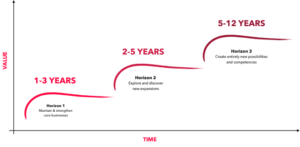With summer behind us and 2021 getting into full swing, many Boards and CEOs are looking at reviewing and updating their strategic plan ahead of the budget preparation next quarter.
At CBB, we’ve been working with a number of different organisations across Australia to facilitate workshops and help to update or create a new strategic plan.
Through this recent experience, I’ve noticed that many organisations are needing to plan and forecast well beyond the usual three-year strategic planning period.
In one example, the client organisation’s main services were delivered to an older and ageing demographic. Analysis showed that their services were required for the next five years but that the ageing of their client base would put the future of the organisation at risk in 10-15 years if new services to younger clients weren’t pursued.
In this case, the client has a strong financial position now and is looking to invest in creating new products and services that will ensure its longer term sustainability. Whilst the next five years appears secure, they know that developing new revenue streams will take time to deliver so they need to start now.
In another example, our client organisation had a strong core business, with several projects underway which will deliver more significant results in the next 2-4 years. Due to the nature of the development pipeline, this organisation needed years to bring new products or services online and deliver value.
For this organisation, the Board are thinking about what the organisation will look like in 5-10 years and what research and development activities or projects need to start now to prepare for that future.
In both of these cases, I have worked with the clients using the Three Horizons Model for strategic planning. This model was created by McKinsey and is captured in the graphic below.
Three Horizons is a strategic planning tool to help organisations think about their growth strategy. It helps organisations especially where there are a portfolio of products/services rather than one singular focus.
The three horizons show three different s-curves – much like a product lifecycle – reflecting different innovations or growth initiatives for your organisation which help take the business from one level to the next.
The length of each time horizon depends on how slow or fast moving your sector is, but the graphic provides an example of this.

One significant benefit that I have observed with this model is that it has provided the Board and CEO with a new language through which to think about the operational and strategic activities of the organisation. By placing new initiatives in to horizon one, two or three, they are allocating priority and setting a timeline against which to measure the performance.
What time horizon are you using to look at your strategic plan?
Are you looking at a three or five year time horizon because that’s what you’ve always done?
Do the internal or external drivers in your sector mean that you should consider a different time horizon?
Even if you don’t feel like this longer term model is for you, then it is worth considering what your goals are short term, medium term and longer term (however you define those time periods) so you can position yourself more favourably and stronger in the future.






